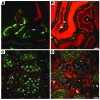Therapeutic translation in acute kidney injury: the epithelial/endothelial axis
- PMID: 24892710
- PMCID: PMC4089444
- DOI: 10.1172/JCI72269
Therapeutic translation in acute kidney injury: the epithelial/endothelial axis
Abstract
Acute kidney injury (AKI) remains a major clinical event with rising incidence, severity, and cost; it now has a morbidity and mortality exceeding acute myocardial infarction. There is also a documented conversion to and acceleration of chronic kidney disease to end-stage renal disease. The multifactorial nature of AKI etiologies and pathophysiology and the lack of diagnostic techniques have hindered translation of preclinical success. An evolving understanding of epithelial, endothelial, and inflammatory cell interactions and individualization of care will result in the eventual development of effective therapeutic strategies. This review focuses on epithelial and endothelial injury mediators, interactions, and targets for therapy.
Figures



Similar articles
-
Overcoming Translational Barriers in Acute Kidney Injury: A Report from an NIDDK Workshop.Clin J Am Soc Nephrol. 2018 Jul 6;13(7):1113-1123. doi: 10.2215/CJN.06820617. Epub 2018 Mar 9. Clin J Am Soc Nephrol. 2018. PMID: 29523680 Free PMC article.
-
Cardiopulmonary bypass, hemolysis, free iron, acute kidney injury and the impact of bicarbonate.Contrib Nephrol. 2010;165:28-32. doi: 10.1159/000313741. Epub 2010 Apr 20. Contrib Nephrol. 2010. PMID: 20427952
-
Pathophysiology of AKI to CKD progression.Semin Nephrol. 2020 Mar;40(2):206-215. doi: 10.1016/j.semnephrol.2020.01.011. Semin Nephrol. 2020. PMID: 32303283 Review.
-
Maladaptive proximal tubule repair: cell cycle arrest.Nephron Clin Pract. 2014;127(1-4):61-4. doi: 10.1159/000363673. Epub 2014 Sep 24. Nephron Clin Pract. 2014. PMID: 25343823 Review.
-
Pathophysiology of ischaemic acute kidney injury.Ann Clin Biochem. 2015 Mar;52(Pt 2):193-205. doi: 10.1177/0004563214556820. Epub 2014 Oct 7. Ann Clin Biochem. 2015. PMID: 25293591 Review.
Cited by
-
Tubular Transport in Acute Kidney Injury: Relevance for Diagnosis, Prognosis and Intervention.Nephron. 2016;134(3):160-166. doi: 10.1159/000446448. Epub 2016 May 31. Nephron. 2016. PMID: 27238156 Free PMC article. Review.
-
Inflammation drives renal scarring in experimental pyelonephritis.Am J Physiol Renal Physiol. 2017 Jan 1;312(1):F43-F53. doi: 10.1152/ajprenal.00471.2016. Epub 2016 Oct 19. Am J Physiol Renal Physiol. 2017. PMID: 27760770 Free PMC article.
-
Acute Kidney Injury: Definition, Management, and Promising Therapeutic Target.Cureus. 2023 Dec 28;15(12):e51228. doi: 10.7759/cureus.51228. eCollection 2023 Dec. Cureus. 2023. PMID: 38283512 Free PMC article. Review.
-
Ultrasound super-resolution imaging provides a noninvasive assessment of renal microvasculature changes during mouse acute kidney injury.Kidney Int. 2020 Aug;98(2):355-365. doi: 10.1016/j.kint.2020.02.011. Epub 2020 Mar 3. Kidney Int. 2020. PMID: 32600826 Free PMC article.
-
14-3-3ζ inhibits maladaptive repair in renal tubules by regulating YAP and reduces renal interstitial fibrosis.Acta Pharmacol Sin. 2023 Feb;44(2):381-392. doi: 10.1038/s41401-022-00946-y. Epub 2022 Jul 15. Acta Pharmacol Sin. 2023. PMID: 35840657 Free PMC article.

